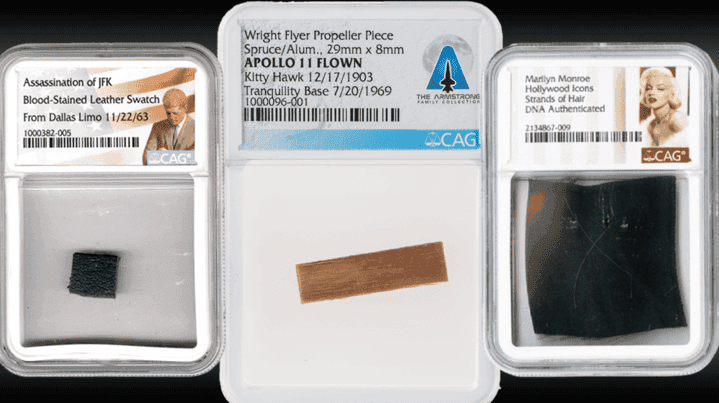There aren’t many people to call when on the hunt for the DNA of a long-dead historical figure.
But, at the top of the list, if there was such a thing, would be John Reznikoff, University Archives founder and expert authenticator of historical documents and memorabilia.
Francois Pomès sought out Reznikoff to help provide the final piece of the puzzle in his years-long hunt to discover the true identity of Marilyn Monroe’s father, which the French documentarian revealed in his 2022 film “Marilyn, Her Final Secret.”

The discovery confirmed Monroe’s father was, in fact, Charles Gifford, a man with whom Monroe’s mother had an affair. Monroe suspected him of being her father for years, despite his denials.
Reznikoff, who had obtained locks of Monroe’s hair from her embalmer, assisted in confirming the link between Monroe and Gifford’s DNA.
While University Archives deals in all matter of historical items, Reznikoff’s unique approach to relics have completely altered the way collectors view the industry.
Reznikoff’s relics, a collection of items consigned through his auction house and acquired over the years by the man himself, are as comprehensive of an overview of history as one could possibly imagine to find in one collection.
He has sold everything from a blood-stained leather swatch from President Kennedy’s Dallas limousine (sold for $14,000 in January 2022) to a fabric swatch from the Wright Brothers’ Kitty Hawk-flown wing (sold for $8,000 in March 2022) — both of which are encapsulated in CAG holders about the size of a matchbook.

Others have sold similar items before, but few thought to take these items and sell them in multiple pieces rather than a singular lot. And nobody has done it to the same level of success. He calls them “relics for the people.”
The idea first came to Reznikoff back in July 2018, when he saw Heritage Auctions sell the personal collection of Neil Armstrong. Among the items from his estate, sold in a series of auctions over the span of about six months, were a number of CAG-encapsulated relics. The two most notable were pieces from the Wright Brothers’ propeller which were carried along during Apollo 11. Each sold for $275,000.
The action of taking larger pieces of fabric and cutting them into smaller relics sparked an idea for Reznikoff, who had dealt with this type of material for decades, often producing similar presentations.
But seeing them in a CAG slab was a game-changer.
“This was a whole new category of collecting,” Reznikoff said. “It’s something that inspires a great deal of confidence with collectors in multiple markets.”
Collectible markets are a topic Reznikoff is particularly well-versed in, having long ago found an arbitrage between the historical/Americana category and the sports sector.
"A (Thomas) Edison clip signature will do better in a sports sale, if it's in a slab, or if I have it in a slab it'll do as well as it does in a sports sale, which is more than historical customers will pay," Reznikoff explained his conduit-like role between the two worlds. "And likewise, if I have an unslabbed Ted Williams that brings 100 bucks in a sports sale, it brings $200 in my sale, because the guys who buy Lincoln and Washington, they're not exposed to the sports stuff as much and they figured 'what the heck' and they'll throw a bid in."
This same strategy of catering to unique markets through alternative presentation is precisely the kind of thinking that brought Reznikoff to his famed CAG-encapsulated relics.

Now, instead of selling a piece of history for a massive sum of money, Reznikoff is able to provide a fragment of the item to a larger audience at a fraction of the price.
Reznikoff is aware that some might view the idea of cutting up relics to be disrespectful to history, which is why he is very particular as to what types of things he will cut up. For example, he acquired a stained and torn polo shirt that once belonged to President Franklin D. Roosevelt. Cutting up this shirt, which would be unfit for display in a museum, aligns with his vision of providing access to history without damaging an important artifact.
One of the most popular of these relics is a swatch from the curtain at Ford’s Theatre the night of Lincoln’s assassination. The curtain had been discarded and taken home by a theatre employee, whose wife soaked it in turpentine to remove the painted scenery and created numerous household supplies, such as tablecloths and sheets.
From the tablecloth, Reznikoff created multiple relics, which sell for hundreds of dollars each, rather than the thousands that would be commanded for an intact piece of curtain.
All in all, Reznikoff estimates he has been involved with 20 to 30 of these projects over the years. Other items include a swatch from George Washington’s velvet cloak, strands of Monroe’s hair (from the collection used to find her biological father) and wood from Walt Disney’s first Hollywood studio.
“Relics can be just as interesting as a nice letter, or a nice book, and sometimes more interesting,” Reznikoff said, emphasizing the importance and pride he feels toward the impact the Monroe relic had.
“I'm very proud of that, because not only can someone own a piece of history, but this is a piece that changed history.”
Will Stern is a reporter and editor for cllct.

